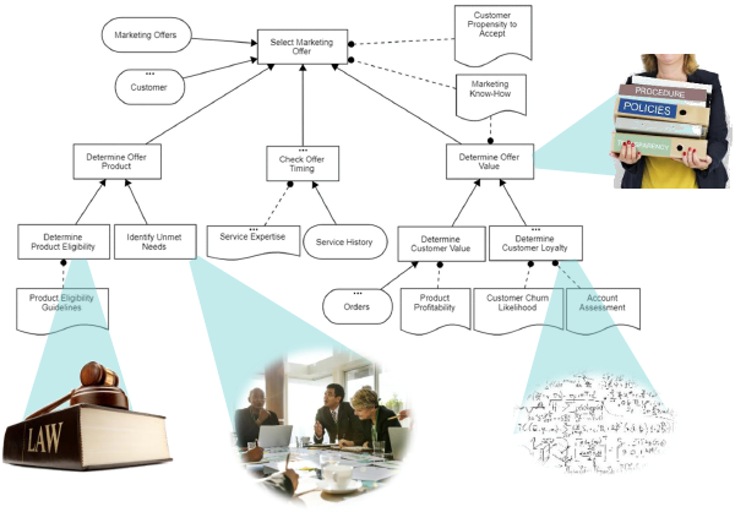The Basics of Operationalizing Your Investment in Machine Learning
Blog: Decision Management Solutions - Decision Modeling
by James Taylor, CEO
Decision Management Solutions
“Enterprises waste time and money on unactionable analytics.1”
This quote from Forrester succinctly states why machine learning (ML) projects often never progress beyond the pilot stage—a common form of “purgatory” and a topic I presented recently at this year’s Machine Learning Week.
Why many ML projects disappoint
ML initiatives get stuck for a number of reasons:
- Multiple proofs of concept generate excitement but are never deployed.
- Pilot projects are deployed but can’t be scaled to the point where value is created.
- Successful use of the ML requires a change in the business that can’t be delivered.
- Projects are deployed and are initially successful but hit a wall when the business changes.
These challenges are pervasive, and many businesses respond in unhelpful ways. They throw more money at technology, hire more staff, or reshuffle the roles on their teams – all surefire ways to continue on this frustrating road to nowhere. When ML isn’t living up to its potential, when your ML initiatives are stuck in purgatory, what you need is a new approach to ML. You need a mindset and an approach that will leverage ML in a way that it adds value to the business
Businesses have forgotten why they are investing in ML in the first place. To derive business value from ML projects, businesses need to go back to basics. They need to remember that the value of ML comes from its ability to improve the accuracy, precision and consistency of decision-making. Because improving decisions is why ML matters, businesses must go back to the decisions they want to improve!
Step away from the data!
Before you make another move and to make sure you’re on the right track, don’t make the mistake of starting with the data. Bart de Langhe and Stefano Puntoni in the MIT Sloan Management Review article “Leading With Decision-Driven Data Analytics,” clearly underscore this point: “Data-driven decision-making anchors on available data. This often leads decision makers to focus on the wrong question: Decision-driven data analytics starts from a proper definition of the decision that needs to be made and the data that is needed to make that decision.”
Decisions! Decisions! Decisions!
You must put decisions, not data, first, to succeed with ML.
The best way to approach an ML project that will yield positive and measurable results is to identify the decision you wish to improve and then build a decision model of how you make that decision today. Whether an informal sketch on a white board or a carefully architected blueprint stored in modeling software, your decision model will identify the specific question to answer, document an overall approach to getting the answer, define the role of ML in the decision, and consider policy and regulatory constraints. More complex decisions and those whose speed and volume require more automation will repay a greater return on investment.
Build a blueprint
Decision models reveal that ML is just a piece of the puzzle—albeit a very useful one that eliminates guesswork and delivers insight from your data. To complete the picture, you need to add another key ingredient: business rules. By articulating all the elements of the decision you’re working, modeling can help you create the right composite of technologies to improve this specific decision. The model will show how to balance decision support and automation, how to determine which parts of the decision to automate, and how to ensure you can make the best use of your ML investment.
First the decision—and then what?
Focusing on and modeling your target decision before you begin puts you on track to successfully operationalize ML and avoid the purgatory of infinite pilots and dead-end deployments. When you operationalize ML, you close the gap between ML and business value.
How do you accomplish this? It’s easier than you might think. First and foremost, as we have explained, it’s absolutely essential to put decisions first. Focusing on the decision is at the core of operationalizing ML and getting business value from it. Start by identifying the decisions associated with the business problem you want ML to solve and then build a decision model so everyone is on the same page. This is a foundational step that sets the stage for the two steps that follow.
The next step is to identify the composite technologies you’ll need. Each decision requires a different mix of technologies. ML can be effectively used with business rules, which express the regulatory and policy-based parts of a decision. This decision-centric composite operate under one umbrella as a Decision Service.
Finally, you want to aim for continuous and gradual improvement in your decision-making. It’s a journey with a constant change of scenery. So be sure you build for change and take into account all those factors that are in constant flux: new data, policies, regulations, competitors, customers, contracts, market demands, and economic conditions. Focus on ongoing improvement—even in small increments—to make your solution sticky over time.
If you follow these steps, you’ll be in great shape and ready to make use of the power of ML.
Interested in learning more about how to best leverage ML in your decision-making process? Read our white paper, “How to Succeed with AI.”
1 The Dawn Of Digital Decisioning: New Software Automates Immediate Insight-To-Action Cycles Crucial For Digital Business John R. Rymerand Mike Gualtieri
The post The Basics of Operationalizing Your Investment in Machine Learning appeared first on Decision Management Solutions.
Leave a Comment
You must be logged in to post a comment.









